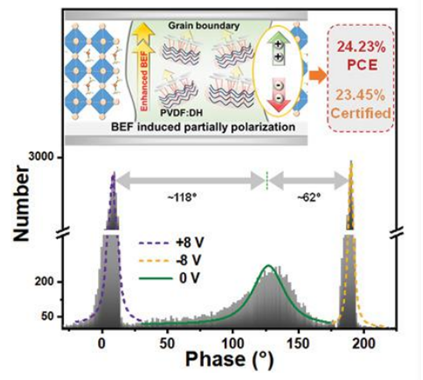High-Polarizability Organic Ferroelectric Materials Doping for Enhancing the Built-In Electric Field of Perovskite Solar Cells Realizing Efficiency over 24%
Weijie Chen 1 , Shuo Liu 1 , Qingqing Li 2 , Qinrong Cheng 1 , Baosheng He 2 , Zhijun Hu 2, *(胡志军), Yunxiu Shen 1 , Haiyang Chen 1 , Guiying Xu 1 , XueMei Ou 1 , Heyi Yang 1 , Jiachen Xi 1 , Yaowen Li 1, 3 ,*(李耀文), Yongfang Li 1, 4
1 Laboratory of Advanced Optoelectronic Materials, Suzhou Key Laboratory of Novel Semiconductor-Optoelectronics Materials and Devices, College of Chemistry, Chemical Engineering and Materials Science, Soochow University, Suzhou, 215123, China.
2 School of Optoelectronics Science and Engineering & Collaborative Innovation Center of Suzhou Nano Science and Technology, Soochow University, Suzhou, 215006, China.
3 State and Local Joint Engineering Laboratory for Novel Functional Polymeric Materials, Jiangsu Key Laboratory of Advanced Functional Polymer Design and Application, Soochow University, Suzhou, 215123, China.
4 Beijing National Laboratory for Molecular Sciences, Institute of Chemistry, Chinese Academy of Sciences, Beijing, 100190, China.
Adv.Mater. 2022, 34, 2110482
The built-in electric field (BEF) intensity of silicon heterojunction solar cells can be easily enhanced by selective doping to obtain high power conversion efficiencies (PCEs), while it is challenging for perovskite solar cells (pero-SCs) because of the difficulty in doping perovskites in a controllable way. Herein, an effective method is reported to enhance the BEF of FA0.92MA0.08PbI3 perovskite by doping an organic ferroelectric material, poly(vinylidene fluoride):dabcoHReO4 (PVDF:DH) with high polarizability, that can be driven even by the BEF of the device itself. The polarization of PVDF:DH produces an additional electric field, which is maintained permanently, in a direction consistent with that of the BEF of the pero-SC. The BEF superposition can more sufficiently drive the charge-carrier transport and extraction, thus suppressing the nonradiative recombination occurring in the pero-SCs. Moreover, the PVDF:DH dopant benefits the formation of a mesoporous PbI2 film, via a typical two-step processing method, thereby promoting perovskite growth with high crystallinity and a few defects. The resulting pero-SC shows a promising PCE of 24.23% for a 0.062 cm2 device (certified PCE of 23.45%), and a remarkable PCE of 22.69% for a 1 cm2 device, along with significantly improved moisture resistances and operational stabilities.

链接://onlinelibrary.wiley.com/doi/10.1002/adma.202110482